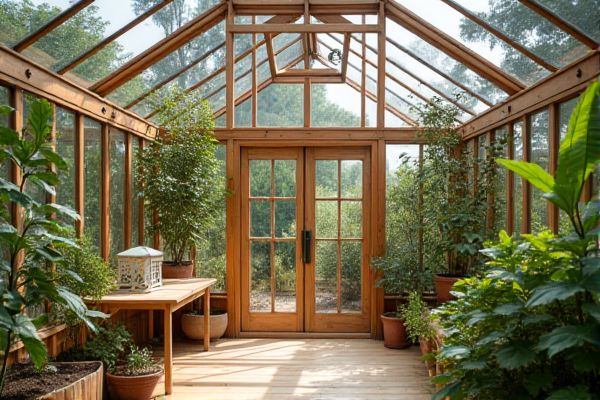
A wooden greenhouse offers natural insulation and aesthetic appeal, while a polycarbonate greenhouse provides durability, UV protection, and lightweight strength ideal for varying climates. Explore the rest of the article to discover which greenhouse material best suits your gardening needs and ensures optimal plant growth.
Table of Comparison
| Feature | Wooden Greenhouse | Polycarbonate Greenhouse |
|---|---|---|
| Material | Natural Wood (e.g., cedar, pine) | Polycarbonate Panels (multi-wall or twin-wall) |
| Durability | Moderate; prone to rot and pests if untreated | High; UV-resistant and impact-resistant |
| Insulation | Good; wood frame offers natural insulation | Excellent; polycarbonate panels trap heat effectively |
| Maintenance | Requires regular sealing and treatment | Low maintenance; easy to clean and no sealing needed |
| Cost | Moderate to high depending on wood type | Moderate; often more affordable than glass |
| Weight | Heavier; affects portability | Lightweight; easier to install and move |
| Environmental Impact | Eco-friendly if sustainably sourced | Less eco-friendly; plastic-based material |
| Light Transmission | Varies; depends on glazing used | High; diffuses light evenly for plant growth |
| Lifespan | 10-20 years with maintenance | 15-20+ years with minimal upkeep |
Introduction to Greenhouse Materials
Wooden greenhouses offer natural insulation and aesthetic appeal, making them ideal for gardeners seeking a classic look and moderate temperature control. Polycarbonate greenhouses feature lightweight, durable panels that provide excellent UV protection and impact resistance, enhancing plant growth through consistent light diffusion. Choosing the right material depends on your climate, budget, and maintenance preferences to optimize your greenhouse's performance.
Overview of Wooden Greenhouses
Wooden greenhouses offer superior insulation due to the natural thermal properties of wood, making them ideal for maintaining stable temperatures in colder climates. Their aesthetic appeal and durability depend on the type of wood used, with cedar and redwood being popular for resistance to rot and pests. While wooden structures require regular maintenance and treatment to prevent decay, they provide a sturdy framework that supports a wide range of glazing options, including glass and polycarbonate panels.
Overview of Polycarbonate Greenhouses
Polycarbonate greenhouses offer superior durability and insulation compared to wooden greenhouses, featuring UV-resistant panels that maintain consistent temperatures and protect plants from harsh weather. Their lightweight yet strong structure reduces maintenance needs, making them an efficient choice for year-round gardening. If you're looking to maximize plant growth with minimal upkeep, your polycarbonate greenhouse provides excellent thermal performance and long-lasting reliability.
Durability and Longevity Comparison
Wooden greenhouses offer natural insulation and aesthetic appeal but require regular maintenance to prevent rot, pests, and weather damage, potentially limiting their longevity. Polycarbonate greenhouses feature high resistance to impact, UV rays, and temperature fluctuations, often lasting 10 to 20 years with minimal upkeep. Choosing a polycarbonate greenhouse enhances durability and long-term performance, ensuring your investment withstands diverse climatic conditions effectively.
Insulation and Climate Control
Wooden greenhouses provide superior natural insulation due to the wood's thermal properties, helping maintain stable temperatures and reducing heat loss during cold weather. Polycarbonate greenhouses feature multi-wall panels that offer excellent insulation while allowing high light transmission, supporting efficient climate control and protecting plants from UV damage. Your choice should consider the balance between insulation efficiency and ease of temperature regulation provided by each material.
Maintenance Requirements
Wooden greenhouses require regular maintenance such as sealing, painting, and treating the wood to prevent rot and insect damage, ensuring longevity and structural integrity. Polycarbonate greenhouses need less frequent upkeep since the panels are durable, UV resistant, and easy to clean, reducing time and effort spent on maintenance. Your choice between these two should consider the balance between aesthetic appeal and the ongoing effort you're willing to invest in preserving the greenhouse.
Aesthetic Appeal and Garden Integration
Wooden greenhouses offer a classic, natural aesthetic that blends seamlessly with garden landscapes, enhancing the visual harmony of outdoor spaces through their warm textures and customizable finishes. Polycarbonate greenhouses feature sleek, modern designs with translucent panels that provide a clean, lightweight look while maximizing light diffusion for plant growth. Garden integration favors wooden structures for traditional settings, whereas polycarbonate options suit contemporary gardens seeking functional minimalism and durability.
Cost Analysis and Budget Considerations
Wooden greenhouses typically involve higher initial investment due to the cost of quality timber and labor-intensive construction, but they offer excellent insulation and durability, potentially lowering heating costs over time. Polycarbonate greenhouses are usually more budget-friendly upfront with lower material and installation expenses, featuring lightweight panels that provide strong UV protection while allowing ample light transmission. Long-term cost analysis favors polycarbonate for maintenance savings and weather resistance, whereas wooden greenhouses may require periodic treatment and repairs that impact overall budget planning.
Environmental Impact and Sustainability
Wooden greenhouses offer enhanced sustainability due to their use of renewable, biodegradable materials with a lower carbon footprint compared to polycarbonate, which is derived from non-renewable petroleum-based plastics. Wood naturally regulates humidity and temperature, promoting a healthier microclimate, while polycarbonate panels, although durable and recyclable, often involve energy-intensive manufacturing processes and can persist in landfills if not properly recycled. Choosing a wooden greenhouse supports eco-friendly practices and aligns with Your goal for reducing environmental impact through sustainable gardening solutions.
Best Choice: Which Greenhouse Suits Your Needs?
Wooden greenhouses offer natural insulation and aesthetic appeal, making them ideal for gardeners seeking durability and a rustic look. Polycarbonate greenhouses provide superior light diffusion, UV protection, and weather resistance, suited for year-round growing with minimal maintenance. Selecting the best greenhouse depends on climate, budget, and gardening goals, with polycarbonate favored for efficiency and wood preferred for traditional charm.
 homyna.com
homyna.com